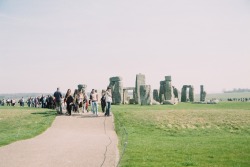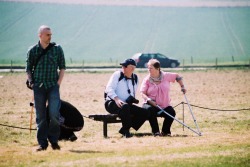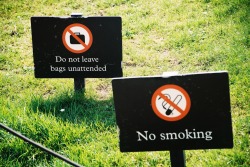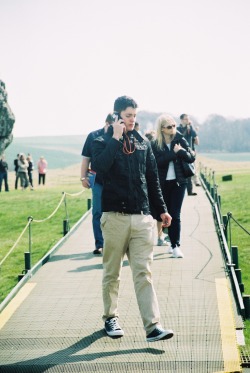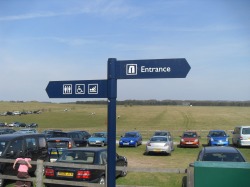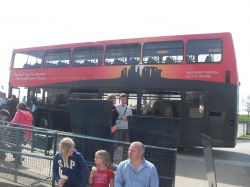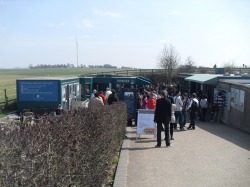What do they offer?
Stonehenge offers its visitors a wide range of facilities. At the visitor centre, tourists will find a large car park for cars and coaches, which will on busy days be expanded onto a nearby field. Although there is a £3 parking fee imposed (and no sign leading up to Stonehenge suggests that drivers have the money ready), visitors will get the money back when they buy their tickets. At the far end of the parking lot are toilet facilities, including baby changing rooms and disabled bathrooms. Although these are signposted, it might prove frustrating to some visitors that there is no toilet facility close to the entrance.
The visitor centre is wheel-chair accessible, and there are no stairs anywhere. The main entrance has a revolving gate, but disabled access can be gained with the help of staff. Staff keep just one spare wheel-chair at the main entrance for visitors with reduced mobility. However, as there is only one, it gets used on a first come, first served basis.
To keep visitors away from the busy A344 which leads to the car park, they approach the monument on the other side of the road through an underpass. The relatively narrow tunnel is the only way in and out, and might prove dangerous in the event of an emergency. Since there is a high fence cornering off the monument from the road, the escape route is blocked. While the first bit of the circular route around Stonehenge is on a wide concrete path, it soon turns into grassland for most of the circuit. A few raised planks with perforated decking for better grip lead visitors over the original ditch and henge past the heel stone and back unto a concrete path, where it rejoins the circuit. One could argue, that the concrete path which leads close to the stones and then away again, has ruined the landscape, as it goes over the ditch twice and therefore intrudes the monument. Having the path half concrete, half grassland also means that visits are weather-dependable. In muddy conditions, the circuit can’t be completed as visitors might get stuck with their boots or wheel-chairs and walking aides. However, the concrete path is wide, so that even large tour groups can squeeze past each other. There are a few wooden benches provided both in the concrete and grassland area of the walk, so that visitors can take a rest and enjoy the view. Since the benches are placed roughly the same distance from each other, it is suggested that they might have been put up for relaxation, instead of the view they are offering.
Visitors to Stonehenge can pick up audio guides at the main entrance for free, and commentary is provided in ten languages including: English, French, German, Japanese, Spanish, Italian, Swedish, Chinese, Dutch and Russian. However, on busy days not every visitor might be able to get an audio guide. Upon purchasing the entry ticket, each visitor is given a small flyer with a map of Stonehenge, and the stone groups and other features of the site names, but not explained. The back of the flyer contains contact information for English Heritage, in case visitors would like to join, and a map detailing nearby historic sites.
Although guards make sure that visitors stay on the path and don’t go inside the stone circle, there are signs placed on the ground all around Stonehenge telling visitors to stay behind the rope and that smoking is not permitted. There are also signs reminding people to watch their belongings. However, since the signs are placed low to the ground, and grass might obscure parts of them, they could be overseen or just illegible for some customers.
Access to the inner stone circle has been prohibited and then by permission only since 1978 to stop erosion and damage to the stones. Many visitors used to carve their names into them or steal stone chippings. Visitors are only allowed to enter the stone circle and walk among the sarsens and bluestones for sunrise and sunset tours that have to be booked at least two weeks in advance. The tours are more expensive, and visitors will have to complete a multi-page application form before being admitted. The group size allowed to enter Stonehenge is between 20 and 30 people to keep damage to a minimum. This is on the one hand helping to conserve the site for future generations; on the other hand it is frustrating for day visitors as they will have to stay on the path. Since Stonehenge was built and aligned with the summer solstice sunrise and winter solstice sunset, many pagan and new age groups flock to Stonehenge on these days – especially for midsummer – to witness the passage of the sun. On these occasions it seems that access to the inner circle is allowed for rituals to be performed, and the management plan lists a solstice attending of 30,000 although the plan does not make it clear whether that is for the month of June or for the day alone. Either way, it shows that while access to the inner stone circle is usually limited, there is no limit on the amount of visitors walking around the monument at any given point, and there are exceptions to the small group rule for the inner circle. Huge crowds in the inner circle seem to contradict the erosion and damage control aim of the management.
The way to the exit leads visitors back through the tunnel and through the gift shop. This is a clever attempt to generate revenue especially from those members gaining free access to English Heritage sites. Jewellery with trilithon pendants and bluestone pieces is on sale, as are various textiles from bags to t-shirts and towels with various pictures of Stonehenge on the front. In April 2010, the favourite image seemed to be a drawing of Stonehenge at sunrise, with the words “Stonehenge Rocks!” emblazoned on across it. Guide books in several languages are for sale as well, as are text books and novels that have the Neolithic Age and Bronze Age or prehistoric monuments as their themes.
Just next door to the shop is a small café, which serves snacks in the form of sandwiches and ice-cream, as well as drinks. Five tables and some chairs can be found in a corner behind the English Heritage office, out of the way of the queuing tourists and opposite the café. Bins are provided, and those who have bought postcards in the gift shop will be able to post them home from the mailbox opposite the main entrance to the site.
Green travel is important to the site’s management, and frequent buses run between Stonehenge and the central bus stop and train station in Salisbury to bring in visitors who do not have cars and are not part of an organised group. The buses are clearly marked with the Stonehenge image on the side, and drop off right outside the main entrance, which encourages the use of public transport, instead of private transport.
What strikes visitors is the lack of interpretative exhibitions or shows, in the visitor centre and at the site itself. There are no panels explaining the artifacts, which can be disappointing for visitors, and especially those who do not get an audio guide.
Although the important facilities are all there, the visitor centre is too small for the number of people who come through it, and especially the two ticket offices next to each other make the main entrance a bottleneck. The management has however put plans for a new, big and enhanced visitor centre at a different location forward.
The visitor centre is wheel-chair accessible, and there are no stairs anywhere. The main entrance has a revolving gate, but disabled access can be gained with the help of staff. Staff keep just one spare wheel-chair at the main entrance for visitors with reduced mobility. However, as there is only one, it gets used on a first come, first served basis.
To keep visitors away from the busy A344 which leads to the car park, they approach the monument on the other side of the road through an underpass. The relatively narrow tunnel is the only way in and out, and might prove dangerous in the event of an emergency. Since there is a high fence cornering off the monument from the road, the escape route is blocked. While the first bit of the circular route around Stonehenge is on a wide concrete path, it soon turns into grassland for most of the circuit. A few raised planks with perforated decking for better grip lead visitors over the original ditch and henge past the heel stone and back unto a concrete path, where it rejoins the circuit. One could argue, that the concrete path which leads close to the stones and then away again, has ruined the landscape, as it goes over the ditch twice and therefore intrudes the monument. Having the path half concrete, half grassland also means that visits are weather-dependable. In muddy conditions, the circuit can’t be completed as visitors might get stuck with their boots or wheel-chairs and walking aides. However, the concrete path is wide, so that even large tour groups can squeeze past each other. There are a few wooden benches provided both in the concrete and grassland area of the walk, so that visitors can take a rest and enjoy the view. Since the benches are placed roughly the same distance from each other, it is suggested that they might have been put up for relaxation, instead of the view they are offering.
Visitors to Stonehenge can pick up audio guides at the main entrance for free, and commentary is provided in ten languages including: English, French, German, Japanese, Spanish, Italian, Swedish, Chinese, Dutch and Russian. However, on busy days not every visitor might be able to get an audio guide. Upon purchasing the entry ticket, each visitor is given a small flyer with a map of Stonehenge, and the stone groups and other features of the site names, but not explained. The back of the flyer contains contact information for English Heritage, in case visitors would like to join, and a map detailing nearby historic sites.
Although guards make sure that visitors stay on the path and don’t go inside the stone circle, there are signs placed on the ground all around Stonehenge telling visitors to stay behind the rope and that smoking is not permitted. There are also signs reminding people to watch their belongings. However, since the signs are placed low to the ground, and grass might obscure parts of them, they could be overseen or just illegible for some customers.
Access to the inner stone circle has been prohibited and then by permission only since 1978 to stop erosion and damage to the stones. Many visitors used to carve their names into them or steal stone chippings. Visitors are only allowed to enter the stone circle and walk among the sarsens and bluestones for sunrise and sunset tours that have to be booked at least two weeks in advance. The tours are more expensive, and visitors will have to complete a multi-page application form before being admitted. The group size allowed to enter Stonehenge is between 20 and 30 people to keep damage to a minimum. This is on the one hand helping to conserve the site for future generations; on the other hand it is frustrating for day visitors as they will have to stay on the path. Since Stonehenge was built and aligned with the summer solstice sunrise and winter solstice sunset, many pagan and new age groups flock to Stonehenge on these days – especially for midsummer – to witness the passage of the sun. On these occasions it seems that access to the inner circle is allowed for rituals to be performed, and the management plan lists a solstice attending of 30,000 although the plan does not make it clear whether that is for the month of June or for the day alone. Either way, it shows that while access to the inner stone circle is usually limited, there is no limit on the amount of visitors walking around the monument at any given point, and there are exceptions to the small group rule for the inner circle. Huge crowds in the inner circle seem to contradict the erosion and damage control aim of the management.
The way to the exit leads visitors back through the tunnel and through the gift shop. This is a clever attempt to generate revenue especially from those members gaining free access to English Heritage sites. Jewellery with trilithon pendants and bluestone pieces is on sale, as are various textiles from bags to t-shirts and towels with various pictures of Stonehenge on the front. In April 2010, the favourite image seemed to be a drawing of Stonehenge at sunrise, with the words “Stonehenge Rocks!” emblazoned on across it. Guide books in several languages are for sale as well, as are text books and novels that have the Neolithic Age and Bronze Age or prehistoric monuments as their themes.
Just next door to the shop is a small café, which serves snacks in the form of sandwiches and ice-cream, as well as drinks. Five tables and some chairs can be found in a corner behind the English Heritage office, out of the way of the queuing tourists and opposite the café. Bins are provided, and those who have bought postcards in the gift shop will be able to post them home from the mailbox opposite the main entrance to the site.
Green travel is important to the site’s management, and frequent buses run between Stonehenge and the central bus stop and train station in Salisbury to bring in visitors who do not have cars and are not part of an organised group. The buses are clearly marked with the Stonehenge image on the side, and drop off right outside the main entrance, which encourages the use of public transport, instead of private transport.
What strikes visitors is the lack of interpretative exhibitions or shows, in the visitor centre and at the site itself. There are no panels explaining the artifacts, which can be disappointing for visitors, and especially those who do not get an audio guide.
Although the important facilities are all there, the visitor centre is too small for the number of people who come through it, and especially the two ticket offices next to each other make the main entrance a bottleneck. The management has however put plans for a new, big and enhanced visitor centre at a different location forward.
